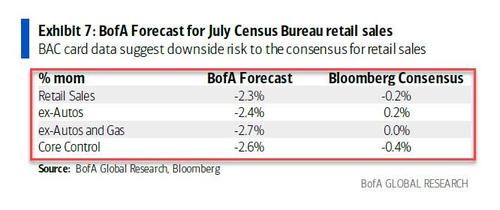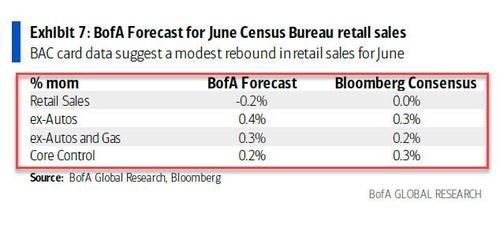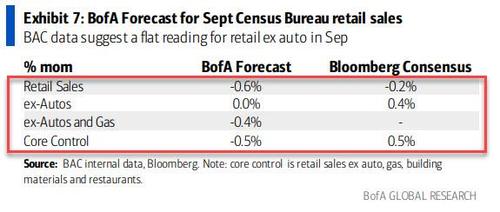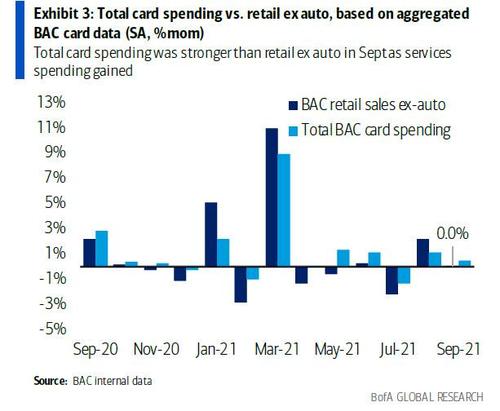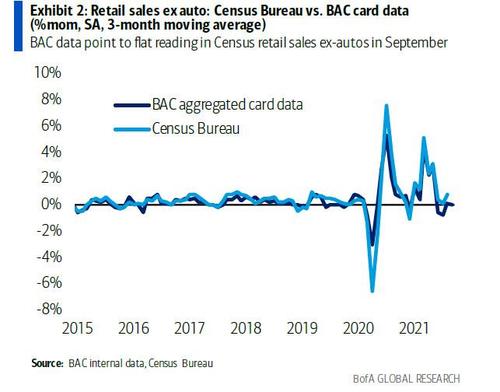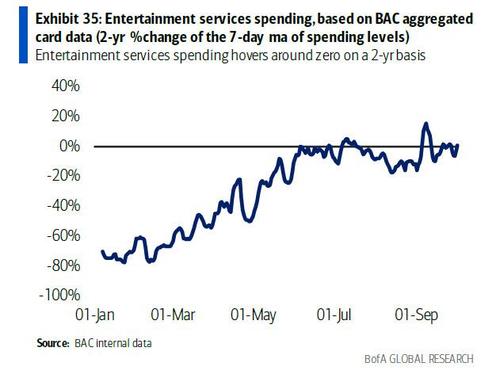Brace For A Retail Sales Miss
Last month, the August retail sales surge was a surprise to many… but not to us. With consensus expecting a modest drop in both headline and core, we tweeted moments before the data was revealed to expect a “big retail sales beat.”
Expect a big retail sales beat pic.twitter.com/tZbpFHYTMi
— zerohedge (@zerohedge) September 16, 2021
How did we know? Because Bank of America, which instead of relying on the hive “knowledge” of a handful of recent Econ PhD grads and a reversion to the mean impulse uses real-time credit and debit card spending data to asses precisely how much Americans are spending at any given moment, knew, and in its preview of the September retail sales print, the bank correctly forecast a big beat.
It wasn’t the first time BofA was right: in fact the bank has been accurate every single month since this spring, usually going against the onsensus herd and coming on top every single time like in August, when it correctly predicted a big drop in the July print…
… the month prior when it and consensus agreed, and both were spot on…
… the month before when BofA once again was correct in calling for a sharp drop and consensus was wrong…
… one month earlier as well…
… and so on.
In short, when it comes to predicting the upcoming retail sales print, toss consensus which has been wrong on 5 out of 6 previous occasions, and listen to the flawless BofA.
So what does the bank forecast the Census Bureau will report tomorrow at 830 when the September retail sales data drop? Well, it will be another miss, with headline coming in about three times worse than the consensus est of -0.2% and ex-autos coming in flat, also missing estimates of a 0.4% bounce.
According to BofA, retail sales ex-autos were unchanged month over month seasonally adjusted (SA) in September.
After accounting for the sharp collapse in unit auto sales to 12.2 million saar (seasonally adjusted annualized rate), as measured by Wards, BofA predicts that tomorrow’s Census Bureau total retail sales will end up down -0.6% mom SA. This follows the sharp swings over the prior two months which owed to a variety of special factors including the timing of the Prime Day promotions.
While the delta between BofA data and Census is small, in a market where a miss is a miss, and a beat is a beat, will certainly be felt. This is how the delta between BofA’s numbers and the Census Burea has looked over time.
In any case, BofA’s chief economist Michelle Meyer contends that this month’s report should give us a cleaner picture of the consumer.
Drilling deeper, within retail ex-autos, spending on furniture and building materials staged a comeback, reflecting the latest turn higher in home sales. BofA also observed a pop in spending on airfare, consistent with the weekly data, working to offset the sharp drop in August. However, spending on lodging continued to contract mom SA (travel related spending is not in the retail ex-autos aggregate).
Also in September, spending at daycare centers was 52% above last year’s level and only 13% below the same time in 2019. BofA sees this as an encouraging sign as reliable childcare is critical for the recovery of the labor force.
While retail sales may miss consensus, it will be modest. Meanwhile, the good news and confirmation that the US consumer remains generally strong, BofA continues to see gains in leisure spending with spending on travel and entertainment, in particular, improving. The bank’s aggregate for leisure spending is running at 1% over a 2-year period, up from the recent low of -8% in mid Sept.
The improvement is not felt evenly across the country, however: in NY and PA spending on entertainment services has been particularly weak (-20% and -12% over a 2-year period, respectively) vs. FL where entertainment is up 16% over a 2-year period.
Once again, it is the south that knows how to party while the northeast excels mostly in locking itself down.
Tyler Durden
Thu, 10/14/2021 – 20:20
via ZeroHedge News https://ift.tt/3iZeWha Tyler Durden
